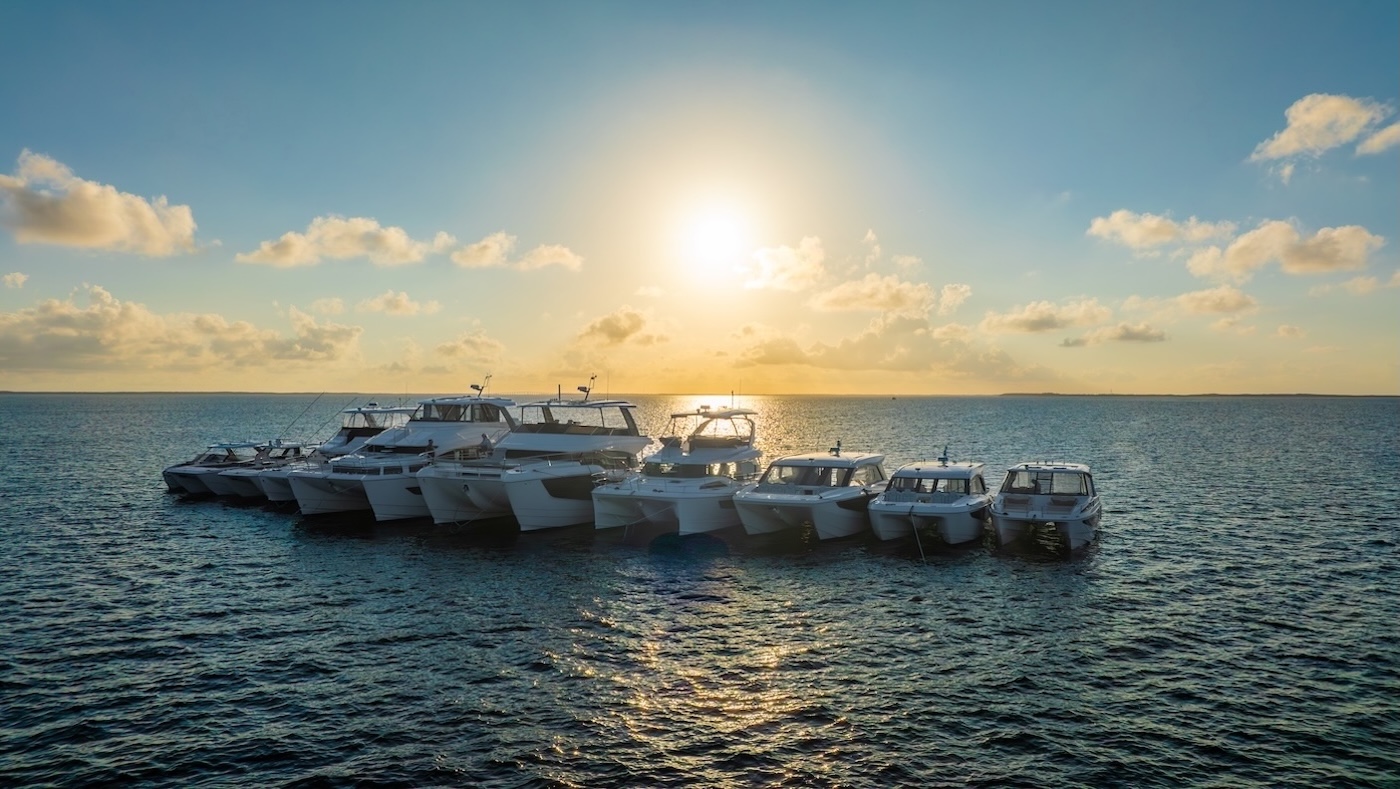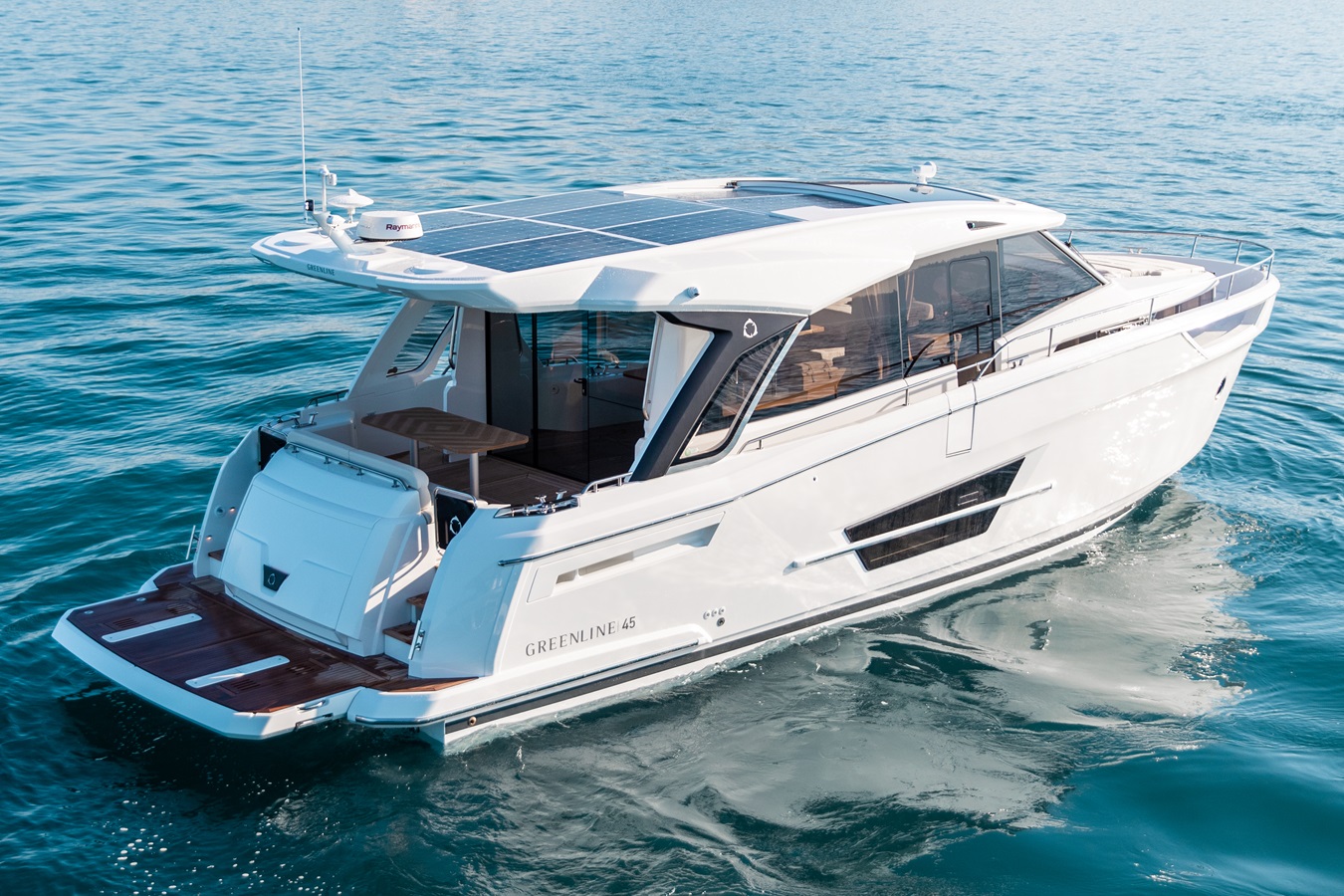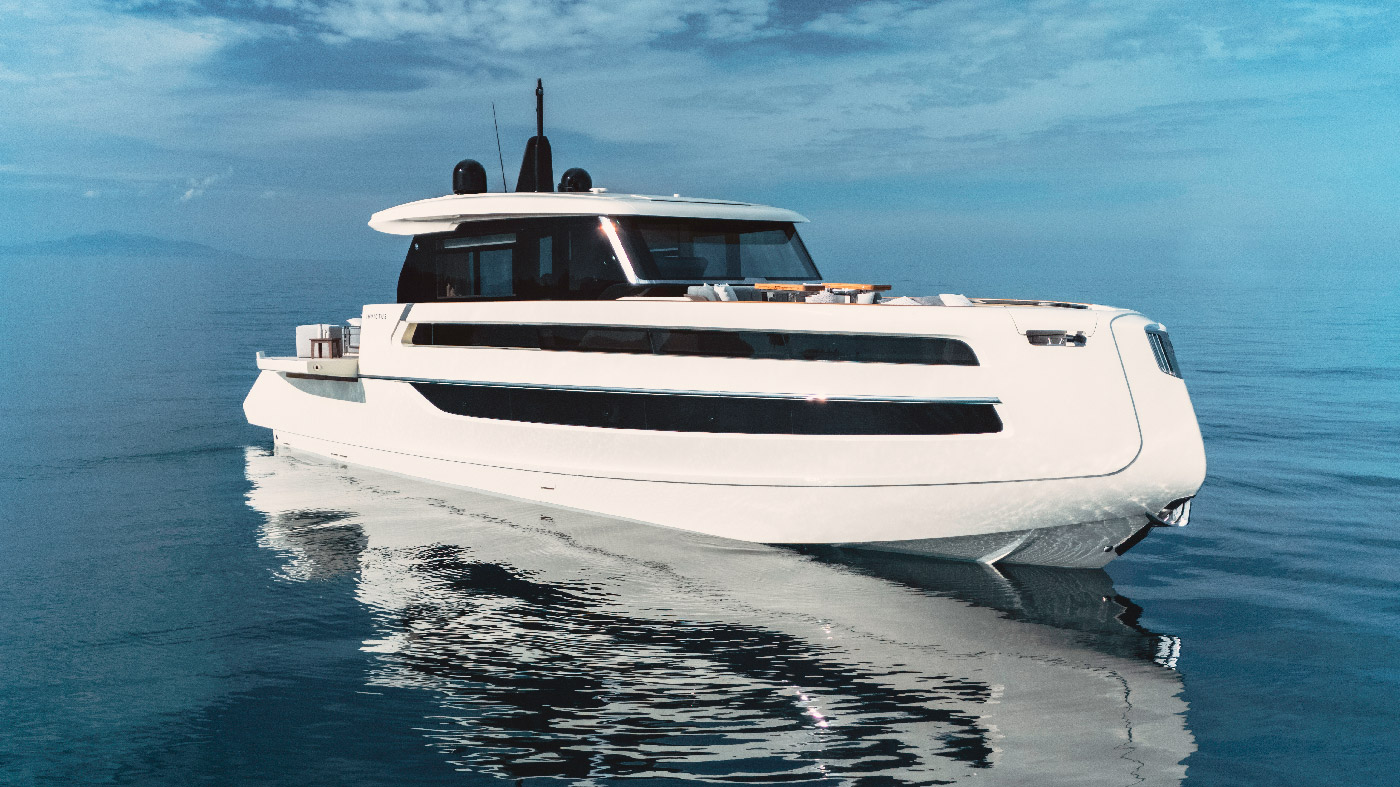It’s almost 15.00 when we arrive in Port Canto, we’re going to take a long interesting stress test aboard new Advanced Yachts A80. It’s hot, we’ve our camera equipment and bags on our shoulders and we walk along a desolate area, where just some days ago Cannes Yachting Festival attracted lots of visitors. APSARAS is moored at the entrance of the harbour but we aren’t seeing her yet, hidden by all the superyachts moored there for the exhibition.
We turn the last corner of the breakwater embankment and we finally see Apsaras. Seen from a distance, she doesn’t look big; like all well-designed boats, she prefers elegance to exaggerated lines.
However, she’s 24 metres long and 6 metres wide.
On the other hand, Reichel-Pugh and Nauta Yachts are excellent designers, always able to produce such masterpieces like this.
Despite the questionable decals her owners, a couple from Hong Kong, have chosen for her, the boat shows her class off like a refined woman.
She even doesn’t care about distances: Apsaras has, in fact, already sailed over 12,000 miles and experienced two Atlantic crossings in little more than 9 months but there is no sign of wear, anywhere.
We’re welcomed by two people we already heard, a very popular team in the world of big yachts, especially among maxi sailing yachts, where skills certainly don’t go unnoticed.
We’re talking about Fabio Beccatini and Cristian Marani, respectively Master and Second-in-command of Apsaras, the maxi yacht we’ll use for our “100 miles aboard” stress test to Genoa.
Advanced A80 is laterally moored. This morning, she took a sea trial with some customers and, when she came back, she was obliged to moor between two sides of the embankment, a very narrow passage (about 40 cm)…
We’re a little late but Fabio solves the situation in just one second, “pulling” with a winch to an astern relieving rope while Cristian deals with the bow from the ground, in no time we are out of trouble and he immediately jumps aboard.
Once we go out of the harbour, we hoist the mainsail and get in route: there’s no wind and sea is flat.
Yanmar 230 HP motor runs at economical cruising speed at 2400 revolutions and 75% of its maximum range with a consumption of about 16-17 l/h, very little for a boat of this size which weights less than 40 tons. We’re sailing at about 10 knots and the stern drags nothing.
With a two-thousand-litre fuel tank, this means an endless autonomy; our fuel tank is full while the water one is at 30% (we’ve a desalination system aboard), which means a load of 2.5 tons including liquids, pantry and crew.
Now that all handlings are completed, we can relax and we quietly admire one of the clearest decks we’ve never seen. The cockpit is huge, an expanse of teak interrupted only by a step which ideally divides the rigging zone from the relaxation one.
All tools in the two wheel houses are on hand and Apsaras is equipped with Raymarine advanced tools, the winch support reserved for the mainsail sheet hosts a large multifunction display.
The two jib winches are well-located, comfortable and far from the relaxation area.
We sail for three hours, the engine is perfectly silent, wind is just 2 knots and we have lots of miles to do despite our 10/11-knot-cruising speed.
In the morning, Christian tells us, true wind was 4-5 knots but this maxi yachtsailed at 6, he adds, but we want to verify that.
Then, wind gets stronger (5-6 knots) and sea gets darker. I turn to the master who smiles, we dont’ need to say anything.
He immediately gives me the wheel, I slightly bear up while looking at the windex, speed increases together with apparent wind, I look down to check the display and we are sailing at 7.6 knots with a 22-degree apparent wind! I go on bearing up and, every time I bear up, apparent wind and speed increase simultaneously.
When apparent wind reaches 30°, we have a speed of 8.8 knots and a true wind of 7.1 which let us slide on a barely chopped sea. Apsaras has just leaned against her bottom line, I turn to check dragging, but nothing..
I bear up again and speed increases more, Fabio and Cristian help me by easing the jib and the big mainsail; at 37°, speed is 9.3 knots and it keeps stable until 60° with apparent wind, I bear up again and we reach 6.9 knots at 75° of apparent wind and about 125° of true one while wind blows at 7.7 knots.
The rudder is direct and sensitive, it transmits everything and its positions, both leeward and windward, are perfect.
However, we’re out of route and Fabio calls us to order, the jib disappears and we start the engine again, it’s 19.00 and we still have over 60 miles to do. After about 10 minutes, even winds decreases and sea surface is clear again. We’re really satisfied and we smile, this Apsaras really ensures high sailing performances.
The Master is a very nice person, he offers to cook some pasta for us, so he quickly disappears below deck where we join him after about half an hour, while sun slowly sets and A80 continues to sail comfortably.
Fabio serves an excellent dish of maccheroncini with capers, olives and ginger, we all have two dishes while me and Cristian alternate as deck guardians while sipping a good red wine.
It’s dark, moon hasn’t appeared yet and a WNW gentle wind starts to blow. We’ve finished in the kitchen, so we release the jib..
Advacend A80 speeds up and lists a little, we reduce motor revolutions and sail at over 12 knots.
Then, wind gives us an unexpected gift, we turns the engine off while it blows at 8.4 knots; we ‘ve 35° of apparent wind and sail at 10.4 knots.
We still have 40 miles to do, we are sailing, sea is almost flat and moon has appeared: everything is perfect!
Wind increases up to 12 knots, Advanced A80 tilts, accelerates and leans against a new bottom line she will never abandon, while speed reaches 13.4 knots.
Apsaras runs and converts every gust into speed. She’s reactive but never nervous. She sails softly on the sea while a thin white track behind, near the bottom line, reminds us that we’re literally flying on water.
Even in these conditions, comfort is always the same, the deck gives us no surprises and we go to the bow to enjoy the show, by leaving the route management to the automatic rudder which makes very few corrections.
Time goes fast, we are about 8 miles off Genoa and wind disappears. We use our engine for the last miles which separate us from the Genoa Boat Show and, some minutes after 01:30, we enter the harbour.
We moor laterally to the gas station, we reach our cabin and we fall asleep with the pictures of this wonderful day printed in our eyes.
Exteriors
Interiors
Technical File
| LOA – L.F.T. | 23.98 m |
| LWL | 21.60 m |
| Max Beam | 6.20 m |
| Draught | fixed keel 3.50 m |
| Unladen displacement | 39.700 kg |
| Construction – Hull | Sandwich with glass elements, carbon reinforcements, impregnated with vacuum-sealed epoxy resin, and unidirectional carbon reinforcements in the more loaded areas. |
| Construction – Deck | Sandwich of carbon fibers, impregnated with vacuum-sealed epoxy resin |
| Ballast | about 11,780 kg (fixed keel) |
| Sailing area | about 326 sq.m. |
| I | 30.20 m |
| J | 8.40 m |
| P | 29.40 m |
| E | 10.80 m |
| Fuel Tank | 2,000 l |
| Water Tanks | 1,300 l |
| Desalination system | 1 x Shenker Modular- about 150 l/h, 220V (OPTIONAL) |
| Auxiliary Engine | YANMAR 4LHA DTP 230 HP @ 3300 RPM |
| Generatore | Onan 17.5 kW QD MDKBN 50 hz (OPTIONAL) |
| Service Batteies | 1200Ah 24V (12 x 12V, 200 Ah) |
| General Concept | Advanced Yachts |
| Exterior and Interiors Styling | Nauta Yachts |
| Designer | Reichel-Pugh Yacht Design |
| Engineer | Sp Gurit |


















































